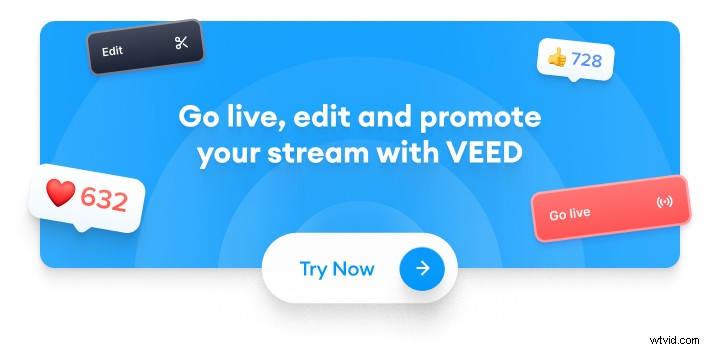Transmisje wideo na żywo to niesamowity sposób na nawiązanie kontaktu z publicznością. Stres związany z perfekcją jako twórcy jest mniejszy niż w przypadku edytowanych filmów. Co jeszcze lepsze:możesz angażować swoich obserwujących, będąc sobą.
A wraz z rosnącą popularnością transmisji strumieniowej transmisja na żywo jest również dobra dla biznesu. Według raportu Hootsuite marki uzyskują siedem razy więcej reakcji i 24 razy więcej komentarzy w transmisjach LinkedIn Live niż w przypadku zwykłych filmów.
Jednak wielu twórców, marketerów lub właścicieli firm nie wie, jak prowadzić transmisję na żywo. Nauka złożonego oprogramowania i wybór odpowiedniej platformy oraz sprzętu do przesyłania strumieniowego przyprawia ich o zawrót głowy.
Czy jesteś jednym z nich?
Nie martw się. Jak zawsze służymy pomocą
Na tym blogu znajdziesz wszystko, co musisz wiedzieć o transmisji na żywo od podstaw. Porozmawiamy o:
- Co to jest transmisja na żywo?
- Jaka jest najlepsza platforma do transmisji na żywo?
- Sprzęt:czego potrzebujesz, aby rozpocząć transmisję strumieniową?
- Pomysły na treści transmitowane na żywo
- Jak transmitować na żywo na wiele platform za pomocą VEED?
- 6 Sprawdzone metody transmisji na żywo

[#TOC1]Co to jest transmisja na żywo?[#TOC1]
Transmisja strumieniowa na żywo to proces nadawania treści wideo w czasie rzeczywistym przez Internet.
Transmisja wydarzeń na żywo, takich jak wydarzenia sportowe lub wiadomości w telewizji, istnieje od dziesięcioleci. Transmisja na żywo jest inna, ponieważ korzysta z Internetu i w wielu przypadkach pozwala widzom na interakcję z wideo poprzez komentarze, reakcje lub dołączenie do transmisji jako uczestnik.
Możesz używać transmisji na żywo do sesji pytań i odpowiedzi, transmitować rozgrywki, podcasty i wiele więcej. Dla twórców treści i marek jest to świetny sposób na bardziej osobisty kontakt z odbiorcami, co zapewnia naprawdę wyjątkowe i wciągające wrażenia.
[#TOC2]Jaka jest najlepsza platforma do transmisji na żywo?[#TOC2]
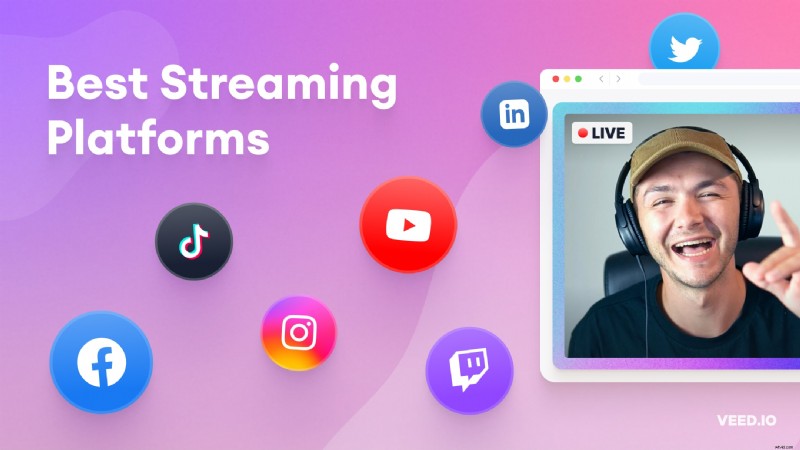
Platforma, na której Twoi docelowi odbiorcy są najbardziej aktywni i zapewnia funkcje wspierające Twoje cele związane z treścią, jest najlepsza. Na przykład, jeśli planujesz wyrobić sobie markę w społeczności graczy i zarabiać na grach, Twitch lub YouTube będą najlepszym wyborem. Prowadzenie pytań i odpowiedzi na żywo na Instagramie zamiast na LinkedIn zwiększy zaangażowanie Twojej transmisji, jeśli jesteś influencerem podróżniczym.
Przyjrzyjmy się popularnym platformom społecznościowym do transmisji na żywo.
🎥 Twitch
Od 1 kwietnia do 30 czerwca 2022 r. na Twitchu obejrzano na całym świecie 5,65 miliarda godzin wideo – to ponad dwa razy więcej niż czas, jaki użytkownicy spędzili łącznie na YouTube Gaming Live i Facebook Gaming.
Witryna zasłynęła z transmisji na żywo z gier, ale obecnie jest znana z różnych kategorii. Na przykład Just Chatting wyprzedził miejsce najczęściej oglądanego typu treści na platformie – dzięki pandemii. Kiedy wszyscy zostali zamknięci w klatkach, rozpoczęli transmisję na żywo na Twitchu, aby nawiązać kontakt ze swoimi społecznościami i zabić nudę.
Twórcy mogą również zarabiać na swoich transmisjach po dołączeniu do programu partnerskiego Twitcha.
🎥 YouTube
Behemot do udostępniania wideo jest drugą najpopularniejszą platformą mediów społecznościowych, z ponad 2,5 miliarda aktywnych użytkowników miesięcznie. Ogromna liczba twórców w YouTube sprawia, że trudno się wyróżnić. Możesz znaleźć streamerów i kanały w kategoriach treści, o których istnieniu nie miałeś pojęcia.
Poproś o dostęp do funkcji przesyłania strumieniowego, jeśli po raz pierwszy prowadzisz transmisję na żywo w YouTube. Ale zatwierdzenie może potrwać do 24 godzin. Po włączeniu możesz rozpocząć przesyłanie strumieniowe jednym kliknięciem przycisku.
| ℹ️ Uwaga:Twój kanał YouTube musi mieć co najmniej 50 subskrybentów, jeśli chcesz transmitować z aplikacji mobilnej. |
Twórcy treści i marki transmitują na żywo na Facebooku, aby łączyć się z dużą bazą użytkowników i rozwijać swoją publiczność i biznes. Możesz przesyłać strumieniowo na Facebooku za pomocą ich aplikacji mobilnych lub komputera.
Pozwala użytkownikom na przesyłanie filmów do swoich obserwujących, stron, grup lub wydarzeń. Ponadto Facebook Live oferuje zaawansowane funkcje, które utrzymują zaangażowanie widzów:ankiety na żywo, polecane linki i moderowanie komentarzy. Jako twórca możesz zarabiać na transmisjach na żywo, korzystając z funkcji gwiazdek na Facebooku.
W ciągu ostatnich kilku lat LinkedIn przekształcił się z portalu rekrutacyjnego i networkingowego w platformę do tworzenia treści. Ludzie korzystają z witryny, aby budować swoją markę osobistą, rozwijać firmy lub znajdować lukratywne oferty pracy. Firmy publikują treści, aby przyciągnąć największe talenty, zwiększyć zyski lub stworzyć pozytywny wizerunek.
Możesz transmitować wideo na żywo na swoim profilu, stronie firmowej lub wydarzeniu. Ale nie każdy może rozpocząć transmisję na żywo w witrynie; musisz spełnić ich kryteria kwalifikacyjne, aby uzyskać dostęp do funkcji transmisji na żywo.
| ℹ️ Uwaga:nie możesz prowadzić transmisji na żywo na LinkedIn bez korzystania z oprogramowania innych firm. |
🎥 TikTok
Popularność TikToka eksplodowała w ciągu ostatnich kilku lat. Krótkie i wciągające filmy w aplikacji sprawiają, że użytkownicy przewijają się przez wiele godzin. Twórcy TikTok często stają się wirusowi w ciągu pierwszych tygodni od opublikowania w porównaniu z platformami takimi jak YouTube czy Twitch.
Aby rozpocząć transmisję na żywo na platformie i zarabiać na swoich transmisjach TikTok, musisz mieć ukończone 18 lat. Aplikacja umożliwia także twórcom dodawanie filtrów i efektów podczas transmisji na żywo. Streamer może przeglądać komentarze, dodawać moderatorów, a nawet zbierać pieniądze na cele charytatywne, korzystając z wbudowanych funkcji aplikacji.
Nie ma ograniczeń co do limitu czasu transmisji. Mimo to zalecamy, aby transmisja na żywo nie trwała dłużej niż 30 minut – biorąc pod uwagę, że publiczność TikTok jest przyzwyczajona do krótkich filmów.
🎥 Twittera
Twitter słynie z krótkich postów tekstowych zwanych tweetami. Twórcy tacy jak MrBeast i marki takie jak Netflix często angażują swoich obserwatorów w witrynie. Możesz mieć transmisje na żywo tylko z dźwiękiem, zwane Twitter Spaces, a także publikować krótkie klipy wideo.
Obsługuje niszową kategorię:wiadomości, wywiady lub zakulisowy przegląd trwającego wydarzenia. Możesz transmitować na żywo na Twitterze za pomocą ich aplikacji na Androida i iOS lub komputera stacjonarnego za pomocą oprogramowania innych firm, takiego jak OBS Studio lub VEED.
Firma należąca do Meta zaczynała jako aplikacja do udostępniania zdjęć, ale z biegiem czasu dodała wiele funkcji, widząc sukces platform takich jak TikTok i Snapchat. Teraz priorytetowo traktuje treści wideo i zastępuje dłuższe filmy Reels. Krótko mówiąc, twórcy i marki wiedzą, że rolki to klucz do rozwoju w aplikacji.
Ale transmisja na żywo na Instagramie pozwala się wyróżnić. Umów się na Instagram Live z innym twórcą lub marką w tej samej lub podobnej niszy i wykorzystaj szansę na rozwój swojego konta.
Jak?
Obserwatorzy użytkownika otrzymują w niektórych przypadkach powiadomienia w swoich aplikacjach, gdy osoba lub konto, które obserwują, zacznie działać. Widząc Cię w transmisji na żywo znajomych kont, użytkownicy z zaciekawieniem sprawdzają Twój profil. Prawdopodobnie klikną przycisk Obserwuj, jeśli opublikujesz odpowiednią treść.
Jak multistreaming zwiększa oglądalność?
Czy nie byłoby fajnie transmitować na jednej platformie zamiast na trzech, powiększać grono odbiorców i zwiększać zaangażowanie widzów? I to też bez wkładania 3X wysiłku.
Brzmi nierealnie?
Umożliwia to multistreaming. Umożliwia twórcom transmisję wideo na żywo na wielu platformach jednocześnie, zwiększając oglądalność.
Więc w czym tkwi haczyk?
Chociaż dotarcie do szerokiego grona odbiorców brzmi atrakcyjnie, pamiętaj o wyborze odpowiednich kanałów. Poznaj głównych odbiorców każdej platformy i upewnij się, że ich zainteresowania są zgodne z treścią Twojej transmisji.
Na przykład, jako gracz, nie udostępniaj multistreamingu swojej gry na LinkedIn — portalu przeznaczonym do rozwoju zawodowego. Zamiast tego wybierz YouTube, Twitch i być może Facebook.
Jednak nauczenie się, jak prowadzić transmisję na żywo na różnych kanałach jednocześnie, może sprawić ból głowy, jeśli nie jesteś obeznany z technologią. Nie martw się, jesteśmy tutaj, aby pomóc.
Platformy takie jak VEED sprawiają, że multistreaming jest prosty i wydajny.
Nie musisz uczyć się ani instalować żadnego skomplikowanego oprogramowania do transmisji na żywo. Rozpocznij transmisję z VEED za pomocą komputera lub laptopa za pomocą jednego kliknięcia.
Wyjaśnimy szczegółowo, jak możesz przesyłać strumieniowo za pomocą VEED, ale najpierw porozmawiajmy o narzędziach potrzebnych do skonfigurowania transmisji na żywo.
[#TOC3]Sprzęt:czego potrzebujesz, aby rozpocząć transmisję?[#TOC3]
MrBeast zaczął od starego laptopa swojego brata i ma ponad 200 milionów obserwujących (szybko rośnie) na swoich kanałach YouTube. Najlepszą drogą jest zacząć po prostu. Ale MrBeast ulepszył również swój sprzęt, gdy tylko zaczął zarabiać, wiedząc, jak ważne jest posiadanie odpowiednich narzędzi do tworzenia wysokiej jakości treści.
Porozmawiajmy o zbudowaniu konfiguracji do przesyłania strumieniowego dla początkujących.
Sprzęt do transmisji na żywo
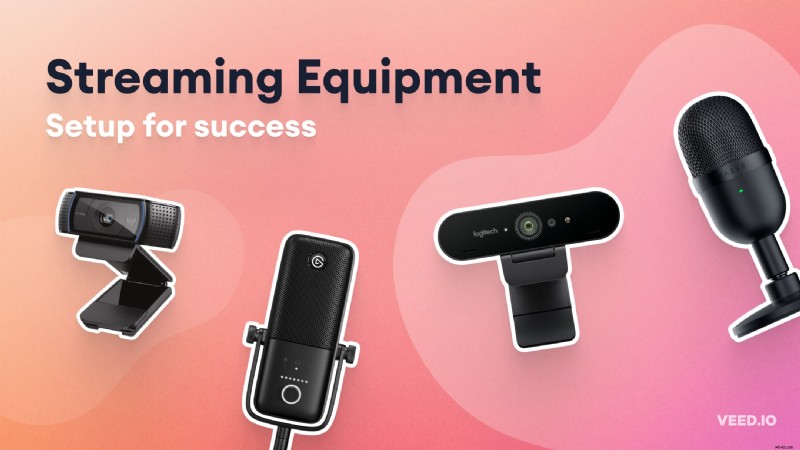
Urządzenie do przesyłania strumieniowego
Będziesz potrzebować komputera lub telefonu z Internetem o przepustowości co najmniej 10 Mb/s, aby nadawać wideo w jakości HD. Idealna prędkość wymagana do przesyłania strumieniowego zależy od rozdzielczości wideo i liczby urządzeń podłączonych do Wi-Fi.
Sugerujemy transmisję na żywo za pomocą laptopa lub komputera, aby mieć większą kontrolę.
Komputer z dużą mocą obliczeniową lub wydajnym procesorem będzie płynnie uruchamiał oprogramowanie do przesyłania strumieniowego i przetwarzał wejście wideo i audio z kamery internetowej i mikrofonu. Na przykład Macbook.
Aby uniknąć problemów, zalecamy korzystanie z komputera z:
- Intel i5 lub równie wydajny procesor
- SSD
- Co najmniej 8 GB pamięci RAM
Większość komputerów PC lub laptopów ma teraz wbudowane karty graficzne do podstawowego przesyłania strumieniowego na żywo. Mimo to będziesz potrzebować solidniejszej i droższej konfiguracji do transmisji gier wideo z dużą ilością grafiki. Niektórzy gracze używają nawet konfiguracji z dwiema konsolami i komputerem do grania.
Kamera internetowa
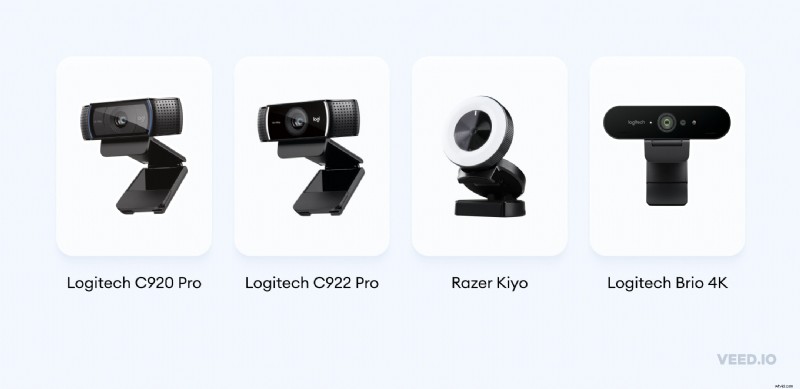
Jeśli masz ograniczony budżet, możesz użyć wbudowanej kamery laptopa, ale zainwestowanie w dobrą kamerę internetową sprawi, że transmisja będzie wyglądać bardziej profesjonalnie. I nie musisz wydawać fortuny na zakup.
Wybierz coś w oparciu o swoje wymagania – czy planujesz transmitować rozgrywki, czy potrzebujesz tego do transmisji na żywo na LinkedIn?
Kup kamerę internetową, która ma co najmniej te funkcje:
- 720p/60 kl./s; Rozdzielczość 1080p/30 FPS
- Oprogramowanie producenta do regulacji ustawień aparatu
- Funkcja autofokusa
- Wbudowany mikrofon
Oto kilka popularnych kamer do transmisji na żywo:
- Kamera internetowa HD Logitech C920s Pro
- Kamera internetowa Logitech C922 Pro HD Stream
- Razer Kiyo
- Kamera internetowa Logitech Brio 4K
Wybraliśmy te kamery internetowe, ponieważ mają doskonałe recenzje online i poleca je wielu ekspertów od strumieniowania. Razer Kiyo wyróżnia się wbudowaną lampą pierścieniową, a Logitech Brio zajmuje drugie miejsce dzięki możliwości przesyłania strumieniowego 4K.
Ich ceny wahają się od 58,99 USD do 129 USD w Amazon US.
| ⚡️ Wskazówka:Sprawdź inne strony z ofertami sprzedaży. Znaleźliśmy ogromną różnicę cen na różnych platformach handlu elektronicznego. |
You can also use your phone’s camera if you’re tight on finances or rarely show your face for video conferencing or content creation; check this Wired article on how to turn your smartphone into a webcam.
Microphone
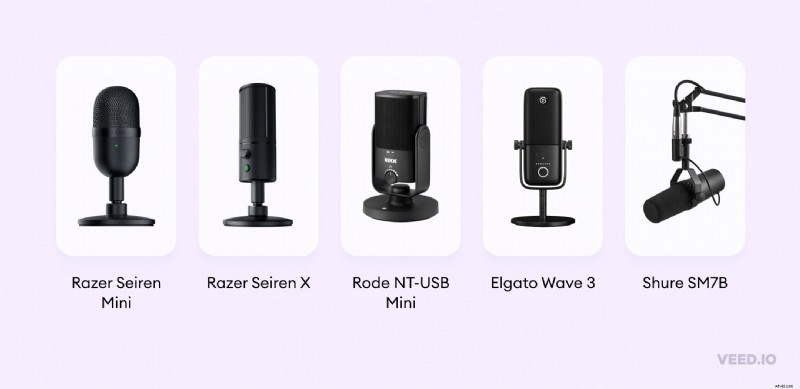
The audio quality of a live stream is equally – if not more important – than the video. People listen to podcasts or videos while doing chores, exercising, or relaxing. Poor audio makes a lousy impression, impacts viewer engagement, and you lose the chance of repurposing the broadcast.
The stream’s audience should be able to hear the speakers loud and clear, so we recommend not using your camera or earphone’s built-in mic.
Buy a microphone that eliminates background noise and gives a balanced sound. Most mics come with two connection types:XLR and USB. XLR mics offer professional-level audio and require a mixer or audio interface to connect the mic to your PC.
But there is a catch. XLR cameras are better but expensive. Go for USB mics, as they are great for newbies.
Here are some of the best streaming microphones for beginners as per streaming experts, content creators, and online reviews:
- Razer Seiren Mini
- Razer Seiren X
- Rode NT-USB Mini
- Elgato Wave 3
The price of these mics starts from $44 on Amazon US. Add a pop filter to your audio setup to further improve the quality.
| ℹ️ Note:Buy Shure SM7B if you’ve got a large budget. It’s a popular choice recommended by many tech publications, streamers, and video creators. |
Natural light or ring light
Bad lighting can make a video look amateurish and unprofessional. The best streaming camera won’t help if you’re broadcasting from a poorly lit room.
However, you don’t have to buy expensive lighting gear as a beginner streamer. Natural light is often a good choice and gives a warm look. And if using sunlight isn't an option, you can go for a ring light.
Moreover, use a combination of a ring light, natural light, and overhead lights installed in your workspace or studio. Preview the lighting on camera before going live and adjust to get the best video quality.
Nice-to-Have (but not necessary for beginners)
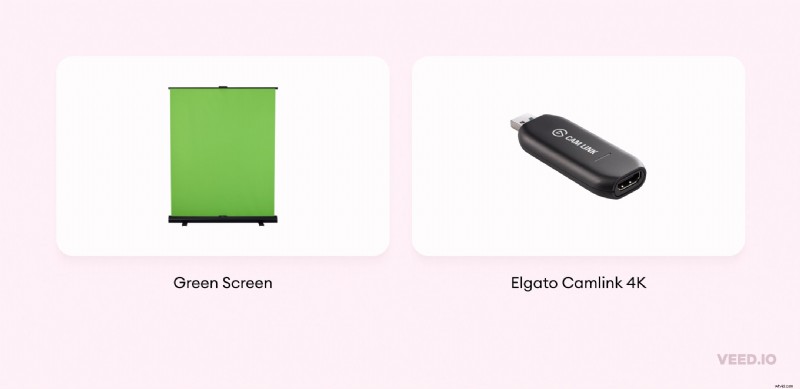
While the setup mentioned above is good enough for most beginner streamers, you can constantly improve the quality. Upgrade your streaming setup if you have the budget and the requirement.
Green screen
Do you want to add customized or video background to your stream?
Or maybe you want to portray you’re sitting in an office?
A green screen could help. It uses chroma key technology to transform a green background into a virtual set. Add branding, CTA’s, or visual effects that could improve the steam quality. Purchase a nylon or muslin screen that covers your camera's field view and has the slightest reflection.
| ⚡️ Tip:To avoid any green screen fails, don’t wear a green outfit, and put the screen at a distance to avoid casting any shadows. |
Capture card
A capture card is a device that transmits the raw footage of a camera or a video source (like Xbox or PlayStation) into a format your computer can recognize and stream.
The card usually connects via the HDMI port of the source using an HDMI cable. You can’t directly transfer video from the camera by connecting it to a computer’s HDMI port. Czemu? Because those are HDMI output ports, they can transmit video signals, not receive them.
The card "captures" what the camera or the video source is recording and then converts and transfers the video signal to your computer.
Elgato Camlink 4K is a popular choice among video creators and has excellent reviews.
| ℹ️ Note:You don't need a capture card while using a USB camera or a webcam. |
DSLR Camera
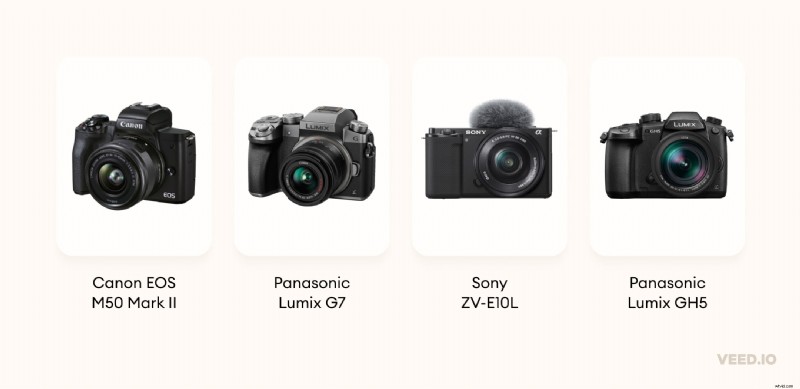
Webcams like Logitech Brio 4K (mentioned earlier) provides superior picture quality, so what’s the need for a DSLR for streaming?
Professional cameras have higher resolution and advanced camera settings, making video quality superior to webcams. You can upgrade a DSLR by adding better lenses and attachments – not a webcam.
However, such cameras are expensive, have a complex learning curve, and need attachments like a capture card to transmit video to a computer. They also need more processing power and might slow down your computer.
Without going into further technicalities, here are some popular DSLR cameras for streaming:
- Canon EOS M50 Mark II
- Panasonic Lumix G7
- Sony ZV-E10L
- Panasonic Lumix GH5
Lighting kit
You can upgrade your video lighting setup if a ring light, natural light, or a room’s lighting isn’t enough. Three-point lighting is popular among streamers because it’s best for one person's setup and combines key light, fill light, and backlight.
You can also use a black background so that it doesn't reflect any light from other sources like incandescent lights or fluorescent bulbs.
Live Streaming Software
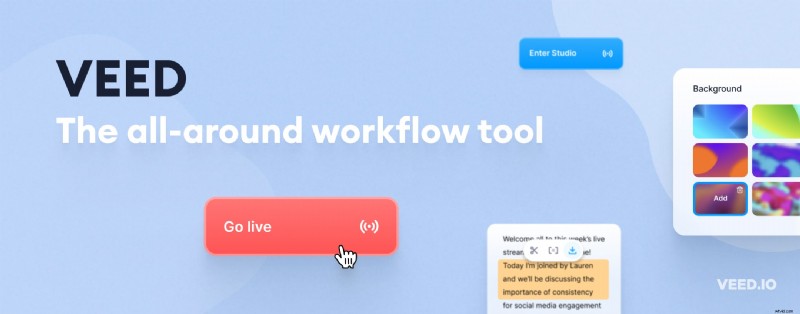
Plug a webcam and a microphone, and go live via a web browser with a click of a button. Sounds simple, doesn’t it?
This is how you can live stream using a free streaming software like VEED .
Here is a list of some other streaming tools:
- OBS Studio
- Streamyard
- Restream
OBS Studio is well-known in the streaming community, offers vast customization options, and allows connecting multiple audio and video sources. But it’s complex to learn, and you’ll have to spend hours on OBS tutorials if you aren’t tech-savvy.
On the other hand, VEED is highly intuitive and allows multistreaming straight from your browser with a few clicks. Use it to easily invite stream participants without integrating it with tools like Zoom or Discord, which OBS requires. Imagine inviting multiple guests for a podcast with only one link. No signups, no hassle -- that is VEED.
It also empowers creators and brands to customize the stream’s design and select different video layouts for consistent branding.
We will talk more about VEED later, but first, let’s discuss live stream ideas for some inspiration.
[#TOC4]10 Live Streaming Content Ideas[#TOC4]
1. Educational How-To Videos
You can educate your audience by sharing your expertise and answering their questions simultaneously. For example, popular course creator and podcaster Pat Flynn discusses a step-by-step process to create a profitable online course.
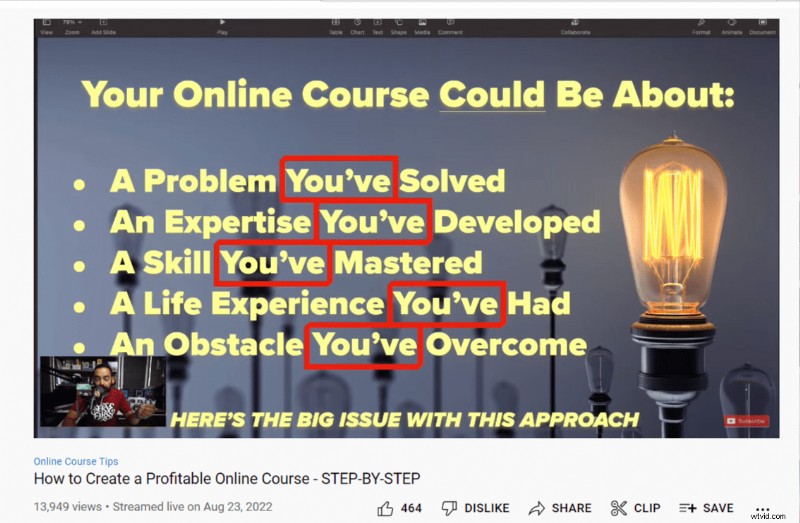
2. Share Your Industry Experience
Share your industry experience and help beginners in the same field.
For instance, VEED’s team of experienced creators did a live stream about what to watch out for when starting as a video content creator. They talk about things like not focusing too much on buying expensive gear and just starting.

3. Launch Event
Use a live broadcast to launch and explain a product. Take Ambreen Nadeem's case as an example. She reveals her first book on LinkedIn Live.
Nadeem also adds viewers to the stream, shares how she came up with the idea and talks about the book structure.
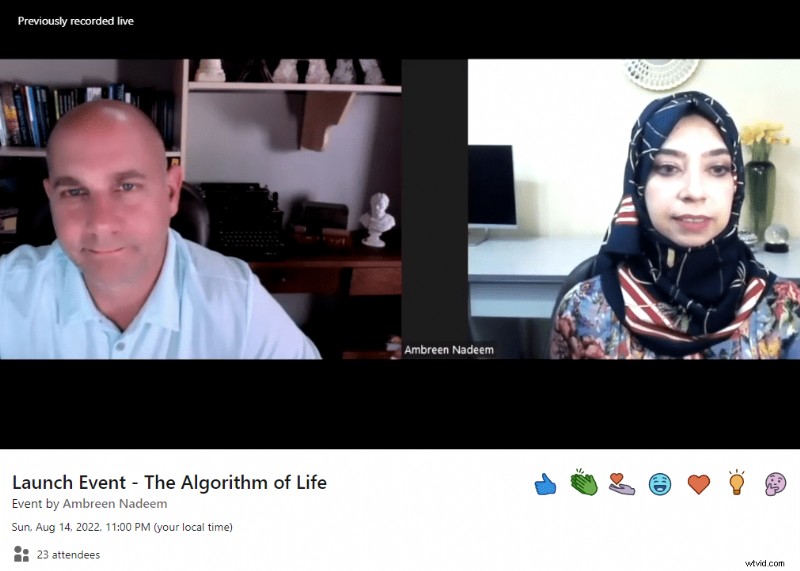
4. Tutorials
Creators can leverage streaming to teach their audience how to do something and connect with their fans simultaneously.
See how the YouTube channel “Dad, how do I?” used the opportunity. Robert Kenney started on YouTube to show kids without dads or bad childhood basic stuff a father would teach them. For example, how to shave or change a tire.
The below screenshot of a live broadcast shows him and his daughter teaching viewers how to carve a pumpkin. The heartwarming comments for the “Internet Dad” will make you smile.

5. Collaborate With An Industry Expert
Invite experts to join you for a live session and discuss things that would benefit your audience. You can collate questions for the expert before the stream or ask viewers to post them in the comment box.
Case in point, see Charlene Brown’s stream on how automation can benefit entrepreneurs. The LinkedIn Live was engaging and had 121 comments.
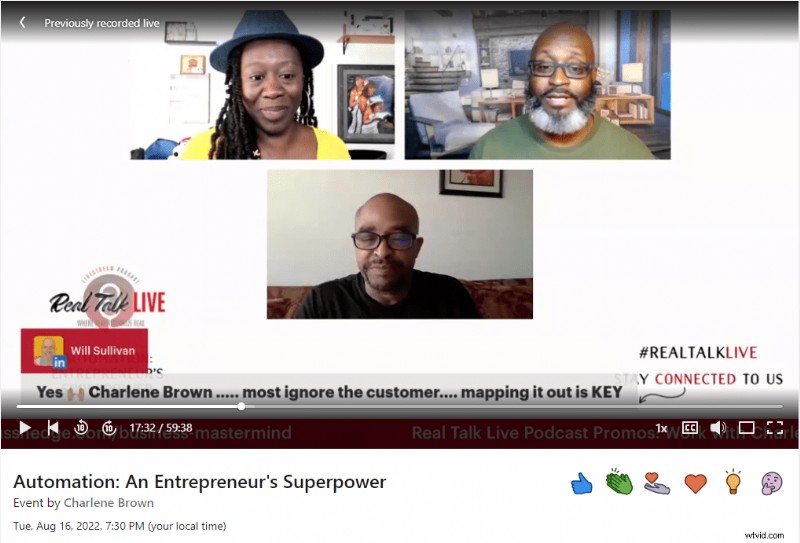
6. Host a Q&A Session
Have a dedicated questions and answers stream. Use the broadcast to show your expertise and care for your viewers. Doing this would help you build a stronger community and upsell after earning people’s trust and establishing yourself as an expert.
“Live Streaming Pros,” as you can guess by the name, is a YouTube channel dedicated to streaming. The channel frequently does live broadcasts to connect with its viewers.
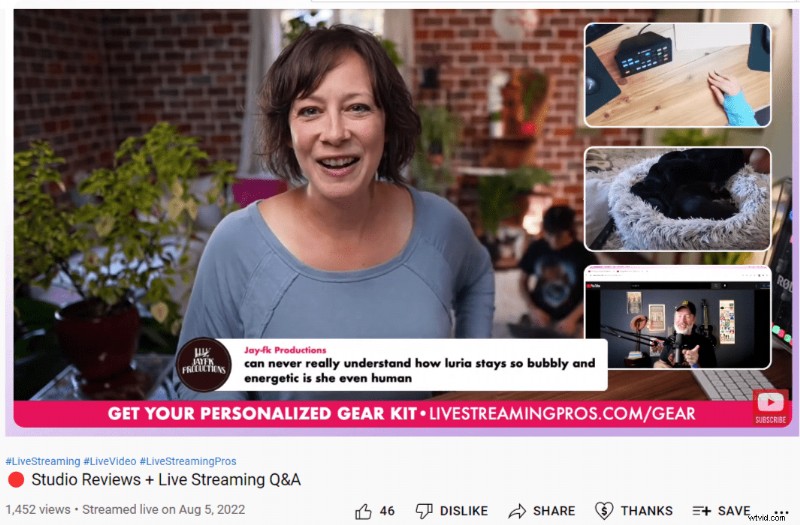
7. Video Games
Gamers can broadcast their gameplays on YouTube, Facebook, and Twitch, and they can also add commentary, do giveaways and monetize their streams.
Customize your stream by adding backgrounds and overlays and create your signature style to stand out. Because the gaming niche is so competitive, we recommend you multistream on different platforms to reach a wider audience.
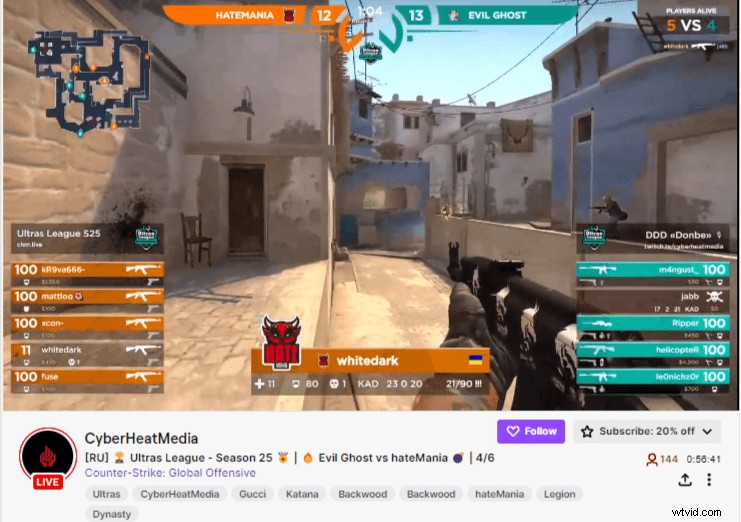
8. Live Critique or Evaluation
You can also use a live broadcast critique work specific to your niche. Evaluate business plans, review code, or show how a graphic could have been better.
Take the YouTube channel The Content Studio as an example. Tommy Walker, an experienced marketer, calls senior writers and editors on the show to share their expertise and edit a draft during a stream.
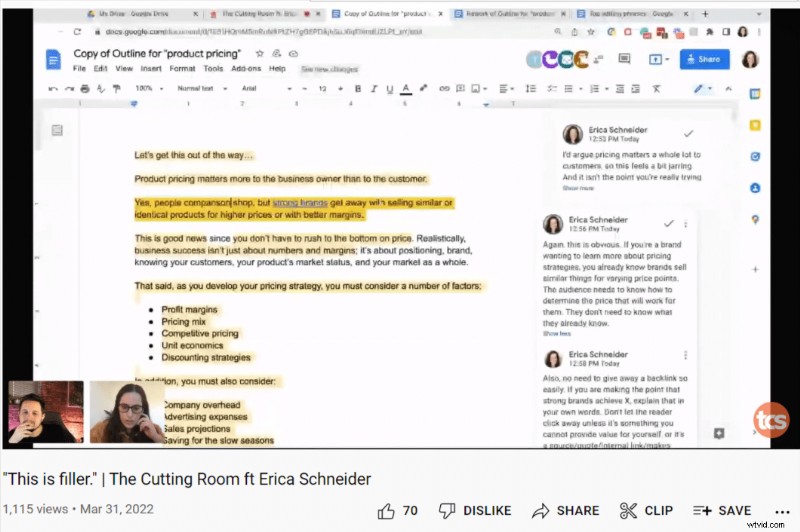
9. Product Unboxing Or Tech Reviews
Suppose you run a channel focused on the latest in tech and gadgets. In that case, you can leverage streaming to do product unboxing or review recently launched phones. Going live allows you to address questions in real-time and increase viewer engagement.
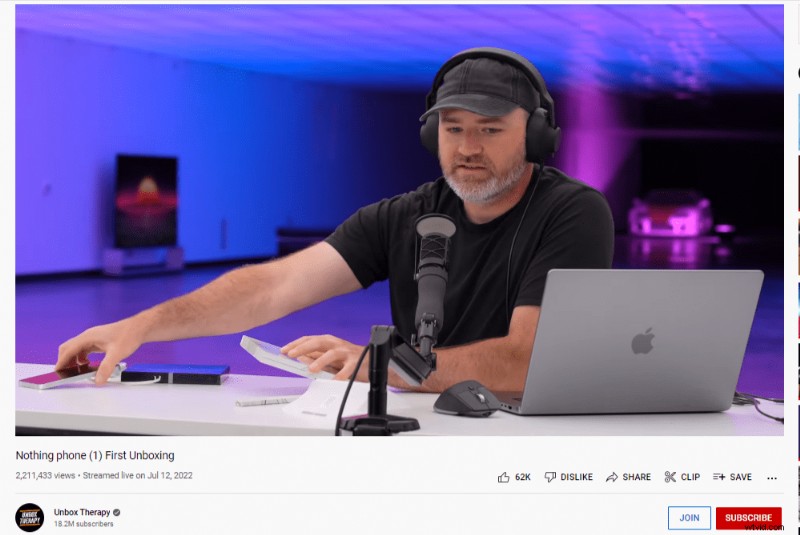
10. Reaction videos
Broadcast a live video reacting to your viewers’ work and suggest how they can do a better job. Omar from Think Media, for example, breaks down and reviews videos shared by others. He also shares pro tips and gives relevant examples.

[#TOC5]How To Live Stream With VEED[#TOC5]
Here is a ten-step process on how to live stream:
- Connect your video and audio devices
- Open www.veed.io in your browser and create a VEED account if you don’t have one
- Click the Go Live button
- Set a display name and adjust your camera and audio settings
- Customize the design of your stream
- Click on Setup broadcast to connect to your preferred platform(s)
- Click on Go Live Now to start streaming using VEED
- Share screen
- View and highlight the comments from different channels
- End the stream and go to the dashboard
Keep reading for a detailed explanation of each step.
1. Connect your video and audio devices
Cameras, microphone, headset, or ring light – connect every device before you start the broadcast.
2. Open www.veed.io in your browser and create a VEED account if you don’t have one
If you have to make a new account, follow the prompts during the signup process until you see an option to choose a VEED plan. Make a choice based on your requirements; see the screen below. Click on the Continue to Workspace link on the top right.
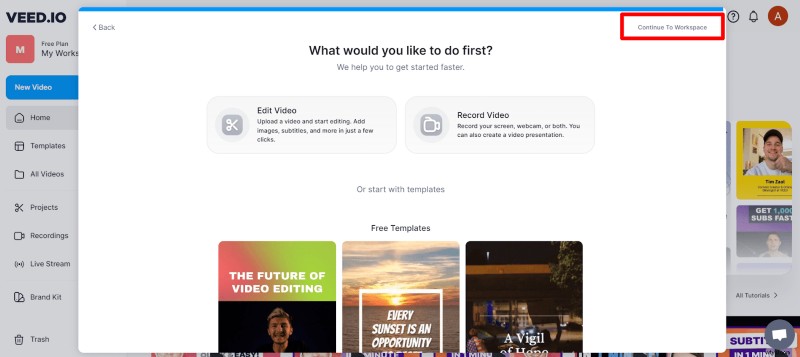
VEED will open your private workspace that looks like the image below.
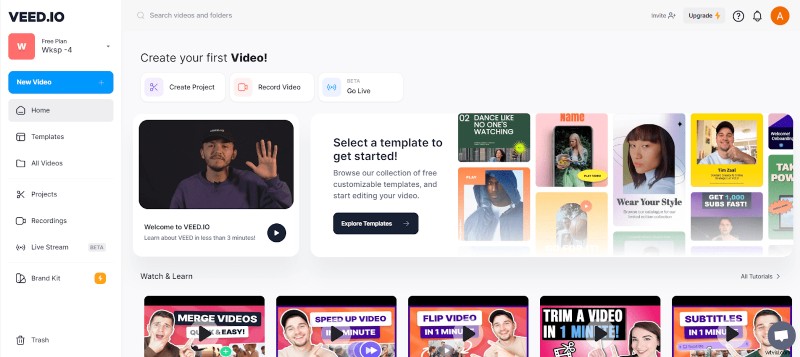
Log in to VEED if you’re an existing user. Whether you sign up for a new account or log in to an existing one, you should be able to see the Home screen of your editing workspace.
For this blog, we are primarily using a free account.
3. Click the Go Live button
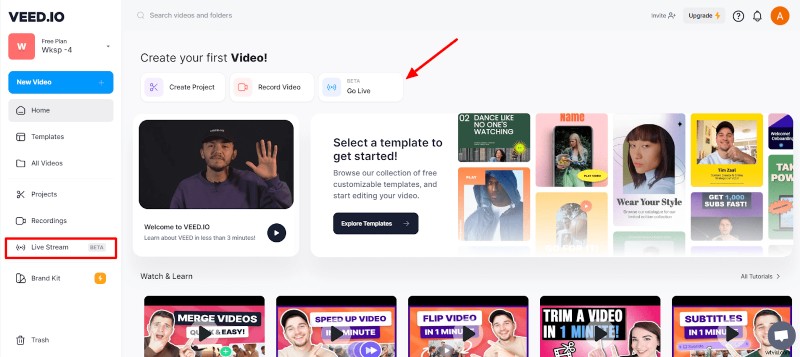
You can also start a live stream by clicking on the Live Stream section on the left panel. Please grant your camera and microphone access if you’re using VEED for the first time.
4. Set a display name and adjust your camera and audio settings
You’ll be able to see the below screen after you click Go Live.
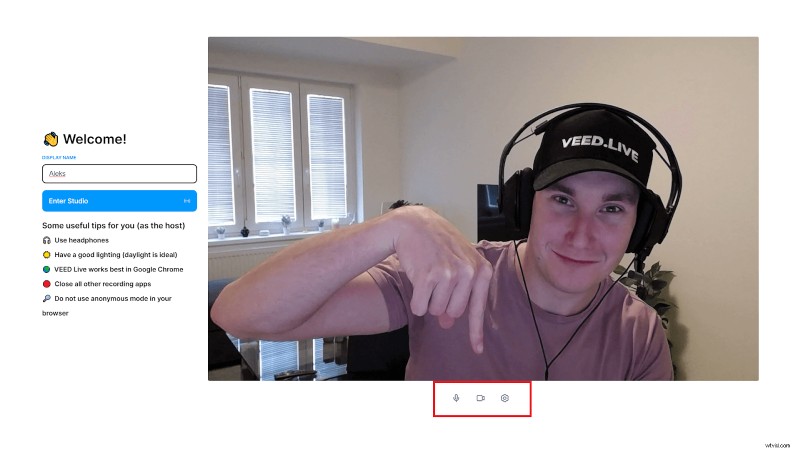
Choose the microphone, camera, and audio output by clicking on the settings icon at the bottom.
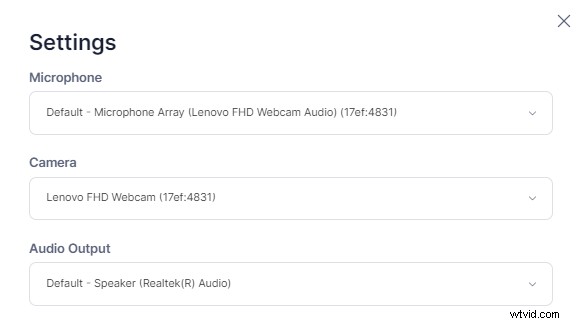
Add the display name, click Enter Studio, and you’ll see the screen below.
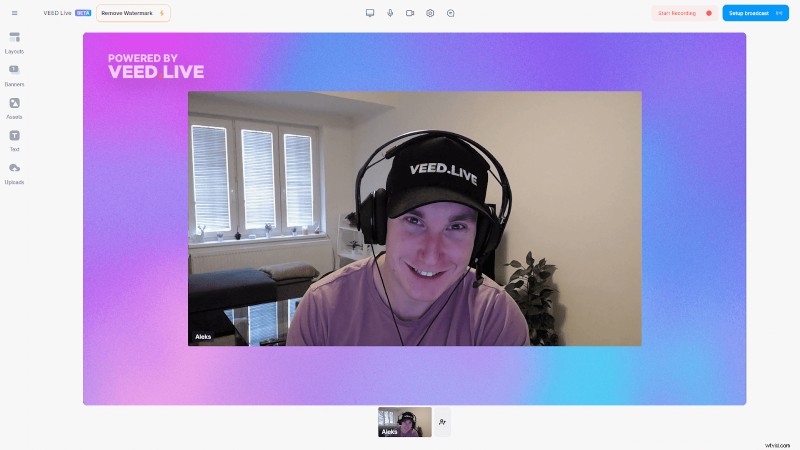
Live stream viewers will see a VEED watermark if you're using a free plan. You can delete this by clicking on the Remove Watermark button to upgrade your plan.

5. Customize the design of your stream.
VEED allows you to customize your stream with various fonts and backgrounds. It also enables creators to add elements like stickers, pop-ups, and logos.
Click on the elements you want to customize on the left-side panel.
In the below image, for example, we have added Twitter and YouTube logos along with VEED’s social handles on these platforms. We have also included the “On Air” sticker and the heading about the topic of the stream.
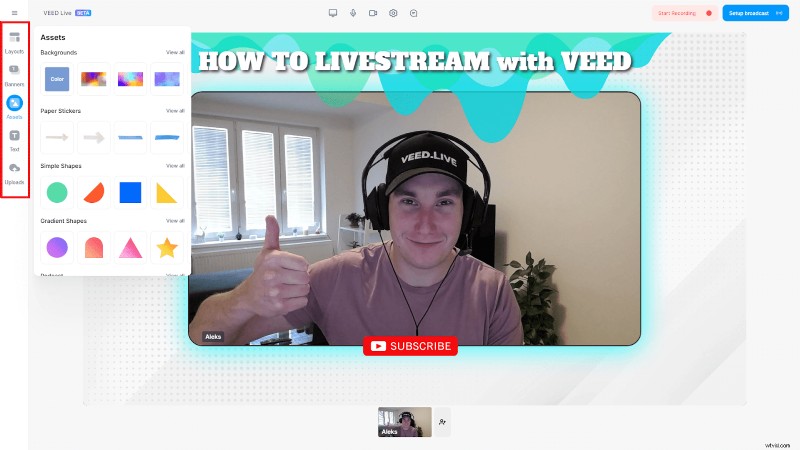
The online platform also offers the functionality to add custom images and backgrounds. And can also allow you to change the stream layout using the options within the Layouts button.
As shown in the image below, the layout options for screen share are disabled, and you’ll be able to use them once you start the screen share.
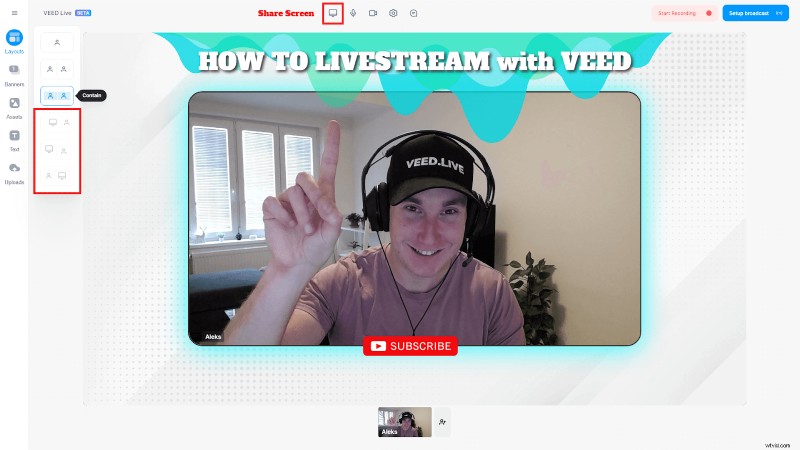
We will talk more about the screen share feature later.
| ℹ️ Note:You can customize your stream’s design while you’re live, but it’s a good practice to set up a basic layout beforehand. |
Now let’s talk about integrating VEED with popular live streaming platforms.
6. Click on Setup broadcast to connect to your preferred platform(s).
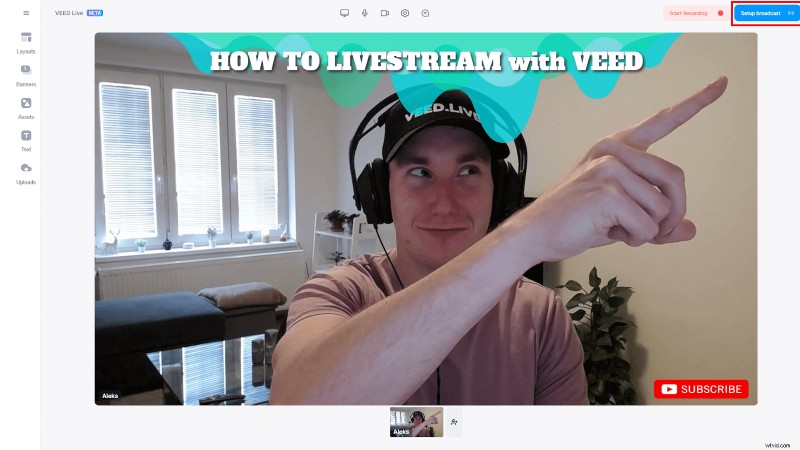
You’ll be able to see the Stream settings pop-up.
VEED saves you the hassle of opening multiple tabs if you want to go live on various platforms.
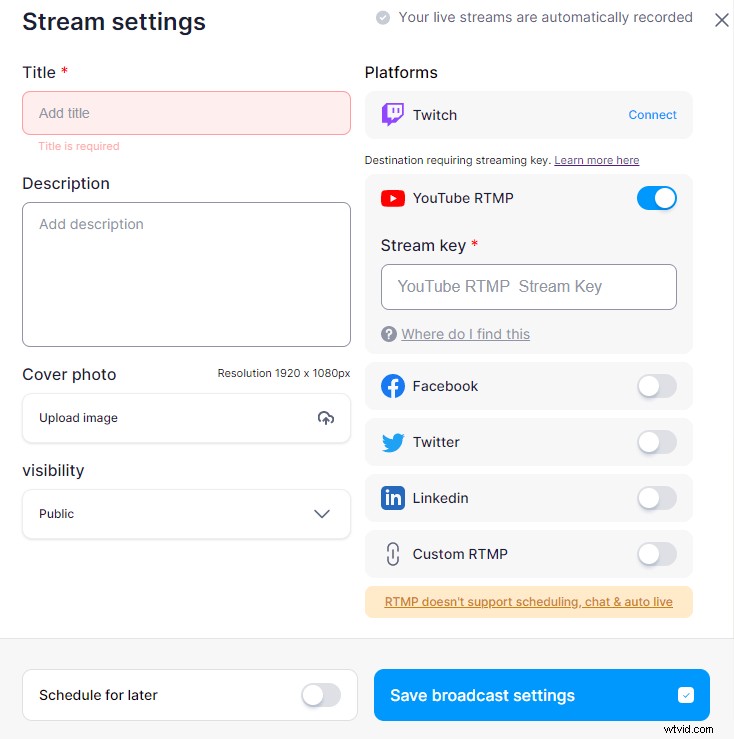
Select the platform(s) you want to stream on and add their respective keys. Add the title, description, and cover image.
Read this guide on how to find your stream key for Twitch, YouTube, Facebook, Twitter, and LinkedIn
| ℹ️ Note:People with access to your stream keys can go live via your social media handles without knowing their respective login credentials. Keep your keys private. |
Suppose you’ve to stream on Twitch and YouTube simultaneously.
After you enter the required details and save the broadcast setting, you will see the logos of the platforms you enabled for streaming in the top-right corner. Having such logos displayed helps you avoid accidentally going live on other channels that you might have connected with VEED for another stream.
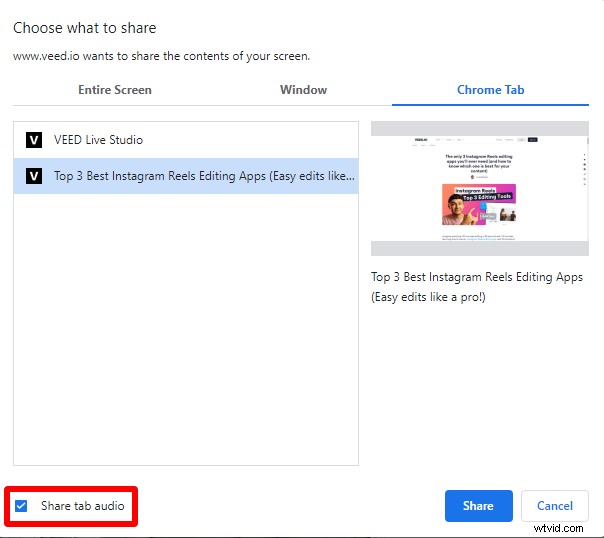
VEED also allows you to add custom RTMP. We don’t want to bore you by getting into the technicalities of RTMP and how it works. In short, you can use the custom feature to live stream on platforms like Vimeo and Microsoft Teams.
Set the stream's visibility as Public, Private, or Unlisted if you’re going live on YouTube. You can also schedule the stream from the broadcast screen.
If you’re a growing creator, we recommend you set the visibility as public so you can reach a wider audience.
7. Click on Go Live Now to start streaming using VEED
The End stream button will replace the Go Live Now button once the stream starts.

VEED automatically starts recording the broadcast the moment you go live.
8. Share screen
As promised earlier, let’s talk about the screen-sharing functionality.
Click on the Screen Share button at the top, and you will see the below pop-up. You can share your entire screen, a window, or a web browser tab. Select the checkbox at the bottom if you want to share the system or tab’s audio.

Click the blue Share button and see the following screen.
Notice that screen-sharing layout options (annotated on the left) that were disabled earlier are now enabled.

Invite others to join the stream by clicking the button at the bottom.

The invitees can join your stream with a click of a button and are allowed to message you in the private chat box.
9. View and highlight the comments from different channels
VEED allows the streamer to see comments from all the channels where the live video is broadcasting in one place:the Public chat box. You can identify a comment’s source based on the platform’s icon attached to it.
Highlight a viewer’s comment by clicking Show on stream . Such small gestures make people feel special. Use banners from the left-side panel to highlight important information or add a CTA.
10. End the stream and go to the dashboard
Click End stream to finish the broadcast and go to the streaming dashboard. Open the recorded stream after it’s rendered.
VEED automatically transcripts the stream’s recording. You can download it as a text or SRT file by clicking on the bottom-right buttons.
Edit the video simply by deleting the text of the transcript to repurpose it for other platforms. It gets even better. You can easily highlight a piece of text and open it in the VEED editor to turn it into a shorter clip for your socials.
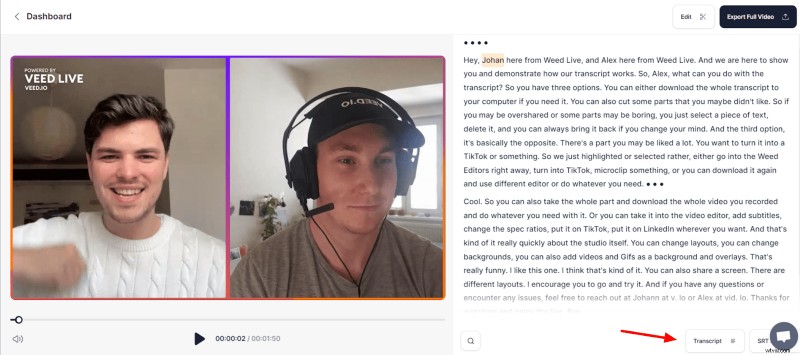
[#TOC6]6 Live streaming best practices[#TOC6]
1. Plan And Prepare Well
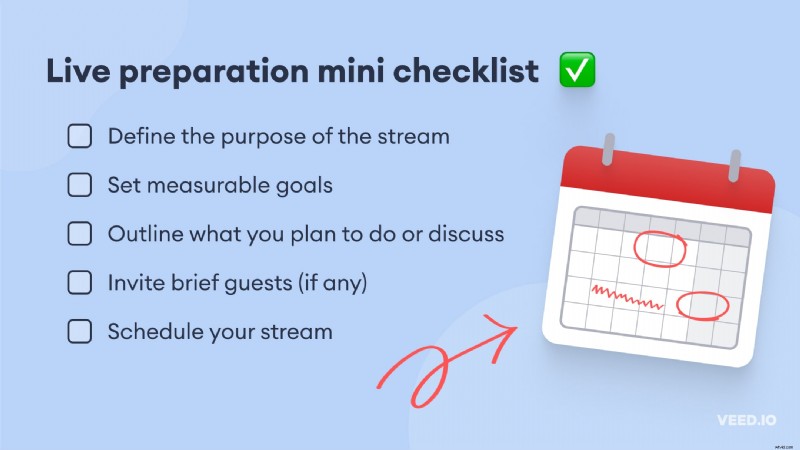
Define the theme and purpose of the stream. Do you want to give a product demo and resolve queries in real time? Or do you aspire to build a more engaged community?
Having a goal will make every aspect of your live streaming strategy manageable. For example, suppose your objective is growing your Instagram followers. In that case, go live with other creators in your niche. Making such strategic decisions increases the probability of attracting relevant followers.
Prepare a rough structure and schedule the stream when your audience is most active on your chosen platform.
Take Tommy Walker from The Content Studio as an example. He gets on a call with his guest a day or two in advance to "figure out the vibe" and loosely discuss the stream's structure. Walker also shares previous episodes that the guest will find relevant.
2. Promote Your Stream
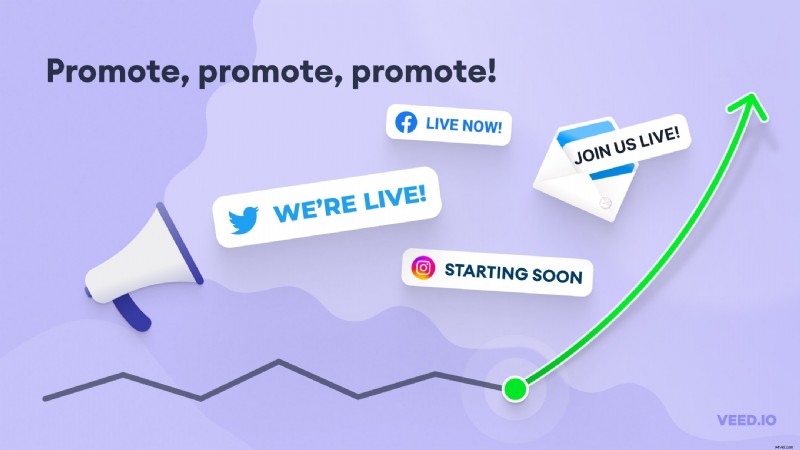
There is no point in going live if you and the stream moderator are the only people who join. Create promotional content and include all the relevant details (date, time, topic) so viewers know what to expect. Then distribute it across social media, email, and forums.
You can also ask your creator friends or employees to promote the stream on their social handles. Remember:the number of people joining your stream is proportional to the excitement you create about it.
3. Test Before Going Live
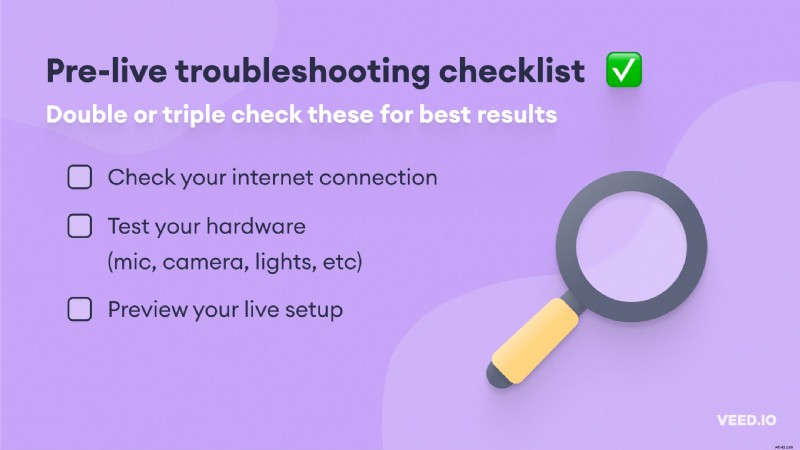
Check your streaming setup before you go live. Start with the internet speed and then move to the hardware:camera, mic, headphones, and lighting equipment. Ensure the streaming software doesn’t show any glitches.
Preview the background and adjust the lighting for the best quality. We also recommend testing special effects like virtual backgrounds and GIFs you may want to use during the broadcasts. It's even better to review everything more than once to avoid surprises during the broadcast.
4. Use Graphics Or Lower Thirds

Customizing and branding your stream using graphics and lower thirds makes the broadcast look more engaging and professional. Add a logo, social media handles, or the call-to-action (CTA) to the broadcast screen. Moreover, you can also include custom banners, backgrounds, and overlays.
We recommend setting up graphics before you start the broadcast. Adding lower thirds or the logo while streaming shows the audience that you are unprepared. Additionally, you’ll have to use third-party streaming software for adding graphics, as most platforms don’t have customization features.
5. Interact With Your Audience Often To Keep Them Engaged
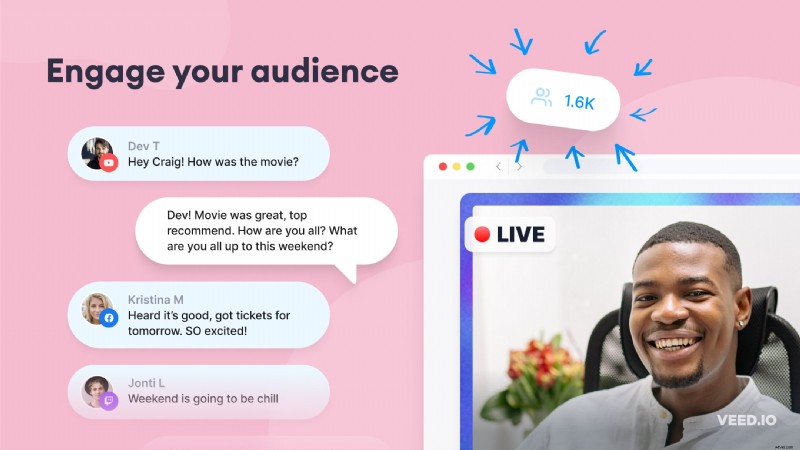
The opportunity for real-time interaction in a live broadcast makes it stand out from comments on a recorded video. Use streaming to make your viewers’ experience more enjoyable. Encourage them to post questions and comments in the chat and respond to as many as possible.
Add viewers to the stream, and hold live polls and quizzes. Even a simple gesture like giving a shoutout or highlighting a comment can make someone’s day.
LinkedIn Live streaming expert Gabe Leal says, "many will resonate with you when you regularly do live video streams. Be mindful that these people want to learn more about you, your knowledge, experience, and story." Leal adds, "connect with them and respond to messages and comments. Share the idea of creating community amongst your audience."
| ⚡️ Tip:Don’t panic if something goes wrong, like glitches with audio or video. People understand it’s a broadcast, and everything can’t be perfect. Being authentic makes you more relatable. |
6. Resize And Repurpose Clips From Your Live Stream For Social Media
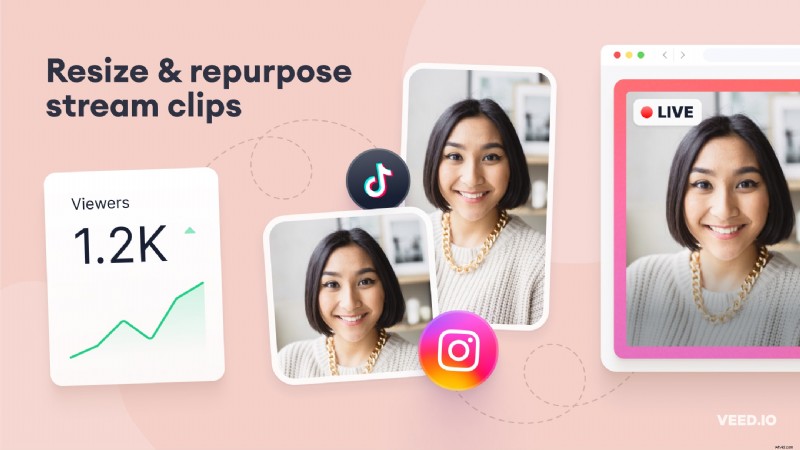
Not everyone has the time to watch lengthy videos. Ending a live stream doesn't mean your work is over. Long-form video content is a content factory. For instance, you can repurpose an hour-long podcast video into many social media assets for different platforms.
How?
Take exciting clips from the video and turn them into Instagram Reels or post them on TikTok. YouTubers like Joe Rogan and Dude Perfect repurpose their videos to YouTube Shorts; why shouldn't you? People are likelier to watch a 15-second clip than listen to a new podcast.
Grab this opportunity to grab people's attention and then ask them to check your website or the longer video. You can use VEED to conduct, record a live stream, and resize the video for different channels.
Final Thoughts
With the popularity of streaming growing, more people and brands will be taking advantage of live broadcasting to spread their message and connect with an audience. Additionally, it is an excellent opportunity to gain loyal customers. However, more popularity means more competition.
You can stand out if you’ve got the right tools for faster and better execution:more live streams, on-brand customization, content repurposing, and much more. But we understand doing so many things can be overwhelming.
Fortunately, there is a simple solution, and it’s called VEED.
We showed you how to live stream with VEED, but it is much more than streaming software. While tools like OBS Studio have advanced streaming capabilities, it has a complex learning curve. Moreover, you’ll have to pay for video editing software if you want to repurpose your broadcast.
On the other hand, you can use VEED to record, edit, and resize the live stream for distribution on various social media platforms. Its intuitive interface, powerful features like subtitle translation, and video and audio conversion make it practically a steal.
Looking to create professional-level streams even when it’s your first time?
Try live streaming with VEED.
